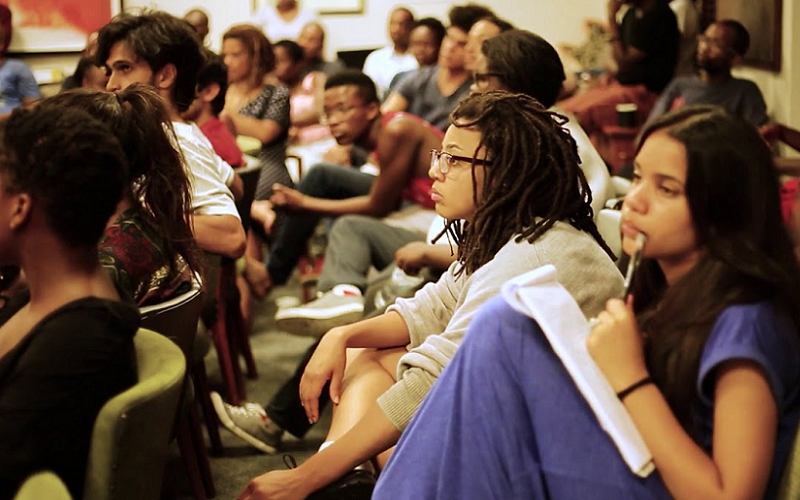
From the early flickers of silent movies to the vibrant hues of modern digital filmmaking, cinema has always been more than just a source of entertainment. It’s a powerful medium that captures the essence of our times, portraying the complexities of human emotions and the nuances of cultural diversity. Films, from blockbusters to indie gems, offer a unique lens into different societies, providing not only a window into other cultures but also a mirror reflecting our own. Cinema transcends borders, facilitates cross-cultural dialogues, and continues to evolve in a globalized world.
Contents
- The Historical Evolution of Cinema
- Diverse Cultural Narratives in Cinema
- Film as a Tool for Social Commentary
- Cross-Cultural Influences and Collaborations in Cinema
- References
The Historical Evolution of Cinema
Cinema, an art form that has become integral to cultural expression worldwide, has a rich and varied history. Here we explore the chronological development of cinema, highlighting how it has evolved from a novel invention to a significant cultural force.
Early Days of Film and Cultural Representation
The birth of cinema can be traced back to the late 19th century, with pioneers like the Lumière brothers and Thomas Edison playing pivotal roles. These early films were simple, often depicting everyday life, but they marked the beginning of a new era in storytelling and cultural documentation. This period was characterized by the novelty of moving images and the exploration of this new medium’s potential.
In these formative years, cinema was primarily a western invention, and its content reflected this. The representation of different cultures was limited and often viewed through a Eurocentric or American lens. However, these early films laid the groundwork for what would become a global phenomenon.
Technological Advancements and Their Impact on Film
As the 20th century progressed, technological advancements profoundly shaped the evolution of cinema. The introduction of sound in the late 1920s, known as the “talkies,” revolutionized the film industry. This development allowed for more complex storytelling and dialogue, making films more engaging and accessible to a broader audience.
The advent of color film further transformed the cinematic experience, bringing vibrant hues to what was once a monochromatic world. These technological leaps not only enhanced the visual and auditory appeal of films but also expanded the creative possibilities for filmmakers, enabling them to convey more nuanced and diverse cultural narratives.
Key Milestones in Global Cinema History
The mid-20th century saw cinema firmly established as a global art form. The post-World War II era, in particular, marked a significant shift, with film industries emerging in countries like Italy, France, India, and Japan. This period gave rise to movements such as Italian Neorealism and the French New Wave, which challenged conventional filmmaking and offered fresh perspectives [1].
The latter part of the 20th century and the early 21st century witnessed the rise of film industries in Latin America, Africa, and Asia, each bringing their unique cultural stories to the global stage. The globalization of cinema not only diversified the types of stories being told but also highlighted the universal nature of human experiences, transcending cultural and linguistic barriers.

Diverse Cultural Narratives in Cinema
Cinema is not just a reflection of society; it’s a mosaic of varied cultural narratives. Here we look into how films from different parts of the world represent and celebrate cultural diversity, offering viewers a window into the lives and stories of people from various backgrounds.
Representation of Different Cultures in Film
Films have the unique ability to transport audiences to different worlds, showcasing the richness and diversity of cultures across the globe. This diverse representation plays a vital role in fostering cultural understanding and empathy.
Hollywood and Western Influence
Hollywood has long been a dominant force in global cinema, shaping perceptions and trends. Its portrayal of different cultures has evolved over time, from stereotypical representations to more nuanced and authentic depictions. This evolution reflects a growing awareness and respect for cultural diversity within the industry [2].
Cinema in Asia: Bollywood, East Asian Films
Asian cinema, particularly Bollywood in India, offers a vibrant and colorful portrayal of its rich culture and traditions. Similarly, East Asian films from countries like Japan, China, and South Korea have gained international acclaim for their unique storytelling styles and cultural depth, often blending traditional themes with modern narratives.
European Cinema and Its Unique Perspectives
European cinema, known for its artistic and philosophical depth, brings a diverse range of cultural perspectives to the global film landscape. From the romantic streets of Paris to the historic landscapes of Italy, these films provide a glimpse into the continent’s rich cultural heritage.
African and Latin American Cinema Voices
African and Latin American films have emerged as powerful mediums for conveying the diverse stories of these regions. These cinemas often tackle complex social and political themes, offering a voice to underrepresented communities and showcasing the resilience and vibrancy of their cultures.
How Films Mirror Societal Values and Beliefs
Films are not just art; they are cultural artifacts that mirror the values, beliefs, and issues of the societies they depict. Through narratives, characters, and settings, films provide insight into how different cultures navigate life, celebrate their heritage, and confront challenges [3].
The Role of Independent Films in Showcasing Diverse Stories
Independent films play a crucial role in bringing diverse cultural narratives to the forefront. Often operating outside the mainstream, these films are free from the constraints of commercial cinema, allowing for more authentic and varied representations of cultures and communities. They are instrumental in telling stories that might otherwise remain unheard, thus enriching our understanding of the world’s tapestry of cultures.

Film as a Tool for Social Commentary
Cinema is more than just a form of entertainment; it serves as a powerful medium for social commentary, offering filmmakers an opportunity to express their views on society’s pressing issues.
Addressing Social Issues Through Cinema
Films have long been used as tools to highlight and critique social issues. From poverty and inequality to racial discrimination and political corruption, cinema has the capacity to bring these issues to the forefront of public consciousness. By presenting stories that resonate with audiences, films can provoke thought, stir empathy, and inspire action.
Films That Have Influenced Social Change
Throughout history, certain films have had a profound impact on society, prompting discussions and even influencing policy changes. For example, movies dealing with environmental conservation have raised awareness and spurred activism. Similarly, films addressing social injustices have often led to increased public awareness and support for various causes [4].
The Power of Documentary Films in Cultural Awareness
Documentary films hold a special place in the realm of social commentary. By presenting real-life issues and events, documentaries provide an unfiltered view of the world. They educate viewers on important topics, often leading to a greater understanding and appreciation of different cultures and social issues. The authenticity of documentaries makes them a potent tool for cultural awareness and social change.
Cross-Cultural Influences and Collaborations in Cinema
The world of cinema is not confined by geographical boundaries. It thrives on cross-cultural influences and collaborations, creating a rich tapestry of global storytelling.
Co-productions Between Different Countries
Co-productions are a testament to the unifying power of cinema. When filmmakers from different countries come together, they bring their unique cultural perspectives, creating films that are diverse in narrative and style. These collaborations often lead to movies that resonate with a global audience, showcasing the beauty of cultural diversity and the universal nature of human emotions [5].
Influence of One Culture on Another’s Cinematic Style
Cinema is an ever-evolving art form, heavily influenced by the exchange of cultural ideas and styles. For instance, the impact of Hollywood on global cinema is undeniable, but the influence is reciprocal. Western filmmakers have often drawn inspiration from Asian, African, and Latin American cinemas, incorporating elements such as storytelling techniques, aesthetic styles, and themes. This cross-pollination enriches the cinematic language, offering audiences new and diverse perspectives.
Global Film Festivals and Their Role in Cultural Exchange
Film festivals play a crucial role in fostering cross-cultural dialogue in the cinematic world. Events like the Cannes Film Festival, Sundance, and the Berlin International Film Festival are not just celebrations of cinema but also platforms for cultural exchange. They provide an opportunity for filmmakers and audiences from around the world to engage with diverse cinematic traditions, promoting mutual understanding and appreciation of different cultural narratives.
References
[1] How movies impact our societies
[2] Cinema reflects society. How real do you think the reflection is?
[3] Movies and Culture
[4] Film as Social and Culture History
[5] The Role of Film in Society

